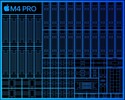Apple M4 Pro (14 cores) vs Apple M4 Max (16 cores)
Apple M4 Pro (14 cores)

Der Apple M4 Pro mit 14 Kernen ist ein leistungsstarker SoC (ARM-Architektur Prozessor ) für Laptops und Mini-PCs, der im September 2024 vorgestellt wurde. Er verfügt über 10 leistungsstarke CPU-Kerne, die mit bis zu 4,5 GHz laufen, sowie 4 effiziente Kerne, die mit bis zu 2,6 GHz laufen. Die 20-Kern M4 GPU und mindestens 24 GB schneller LPDDR5x-Speicher mit 273 GB/s (je nach Konfiguration) sind ebenso enthalten wie USB 4 und Thunderbolt 5-Unterstützung.
Die integrierte neuronale Engine mit 16 Kernen (bis zu 38 TOPS) findet sich in der gesamten M4-Chipfamilie. Darüber hinaus wird angenommen, dass alle M4-Prozessoren bis zu einem gewissen Grad auf der ARM v9.4-A Architektur basieren.
Performance
In unseren Tests lieferte der M4 Pro Multi-Thread-Benchmark-Ergebnisse, die denen des 16-Kern M3 Max als auch mit dem Intel Core i9-12950HX. Eine leichte Verbesserung von Generation zu Generation ist offensichtlich, aber es sind die neuen integrierten Grafikkarten, die die wahren Stars der Show sind.
Grafiken
Die 20-Kern M4 GPU bietet Hardware-Unterstützung für Raytracing, Mesh-Shading und andere moderne Technologien. Sie unterstützt externe Bildschirme mit Auflösungen bis zu "8K" und kann einige beliebte Videocodecs wie h.264, h.265 und AV1 HW-dekodieren.
Seine Gaming Performance ist mindestens so gut wie die der GTX 1660 Ti Laptop. Bitte beachten Sie, dass nur sehr wenige Spiele speziell für Apple Silizium-Macs kompiliert wurden, so dass die meisten Titel über Emulationsschichten ausgeführt werden müssen. Einige von ihnen werden daher mit visuellen Artefakten angezeigt oder starten überhaupt nicht.
- Die Witcher 3 1080p Ultra = 53 fps (ähnlich wie bei der GTX 1660 Ti Laptop)
- Baldur's Gate 3 1440p Ultra = 42 fps (ähnlich wie beim GeForce RTX 4050 Laptop)
- Cyberpunk 2077 2.1 Phantom Liberty 1080p Ultra = 40 fps (nahe an der GTX 1660 Ti Laptop)
Stromverbrauch
Bei starker CPU- und GPU-Last verbraucht das SoC kurzzeitig etwa 80 W, bevor es sich später bei etwa 70 W einpendelt. Ohne jegliche Last begnügt er sich mit 2 W bis 7 W. Ein einzelner P-Core des Chips verbraucht unter hoher Last etwa 6 W.
Der 3 nm TSMC-Prozess der 2. Generation, mit dem der M4 Pro gefertigt wird, bietet eine gute Energieeffizienz (Stand Ende 2024).
Apple M4 Max (16 cores)
► remove from comparisonThe 16-core Apple M4 Max is a powerful ARM architecture processor (SoC) for laptops and mini-PCs that debuted in Sep 2024. It features 12 performance CPU cores running at well over 4 GHz along with 4 efficient cores running at under 3 GHz. The 40-core M4 Max GPU and at least 48 GB of fast 546 GB/s LPDDR5x on-package memory depending on the configuration are included as well, as is USB 4 and Thunderbolt 5 support.
The built-in 16 core neural engine (up to 38 TOPS) is found across the whole M4 chip family. Furthermore, all M4 processors are thought to be based on the ARM v9.4-A architecture to a certain degree.
Performance
The M4 Max is set to be just around 15% faster than the 16-core M3 Max. This is very, very impressive.
Graphics
The 40-core M4 Max GPU has hardware support for ray tracing as well as mesh shading and other modern technologies. It supports external displays with resolutions as high as "8K" and it can HW-decode a few popular video codecs such as h.264, h.265 and AV1.
Its gaming performance is set to be about as good the GeForce RTX 4070 Laptop. Please keep in mind that very few games have been compiled specifically for Apple silicon Macs meaning most titles have to be run via emulation layers. Some of them are displayed with visual artefacts as a result, or don't start at all.
Power consumption
To let so many CPU and GPU cores breathe, some really high TDP figures are required. We assume the chip consumes 90 W to 100 W when under full load.
The 2nd generation 3 nm TSMC process the M4 Max is built with delivers good power efficiency, as of late 2024.
| Model | Apple M4 Pro (14 cores) | Apple M4 Max (16 cores) | ||||||||||||||||||||||||||||||||||||||||||||||||||||||||
| Series | Apple M4 | Apple M4 | ||||||||||||||||||||||||||||||||||||||||||||||||||||||||
| Serie: M4 |
|
| ||||||||||||||||||||||||||||||||||||||||||||||||||||||||
| Clock | 2592 - 4512 MHz | 2592 - 4512 MHz | ||||||||||||||||||||||||||||||||||||||||||||||||||||||||
| L2 Cache | 4 MB | 4 MB | ||||||||||||||||||||||||||||||||||||||||||||||||||||||||
| Cores / Threads | 14 / 14 10 x 4.5 GHz Apple M4 P-Core 4 x 2.6 GHz Apple M4 E-Core | 16 / 16 12 x 4.5 GHz Apple M4 P-Core 4 x 2.6 GHz Apple M4 E-Core | ||||||||||||||||||||||||||||||||||||||||||||||||||||||||
| TDP | 40 Watt | 90 Watt | ||||||||||||||||||||||||||||||||||||||||||||||||||||||||
| TDP Turbo PL2 | 46 Watt | |||||||||||||||||||||||||||||||||||||||||||||||||||||||||
| Technology | 3 nm | 3 nm | ||||||||||||||||||||||||||||||||||||||||||||||||||||||||
| Features | Unified Memory LPDDR5X-8533 (273 GB/s), 16-Core Neural Engine, Media Engine (Encoding / Decoding: H.264, HEVC, ProRes, ProRes RAW, AV1 Decoding only) | Unified Memory LPDDR5X-8533 (546 GB/s), 16-Core Neural Engine, Dual Media Engine (Encoding / Decoding: H.264, HEVC, ProRes, ProRes RAW, AV1 Decoding only) | ||||||||||||||||||||||||||||||||||||||||||||||||||||||||
| iGPU | Apple M4 20-core GPU | Apple M4 40-core GPU | ||||||||||||||||||||||||||||||||||||||||||||||||||||||||
| Architecture | ARM | ARM | ||||||||||||||||||||||||||||||||||||||||||||||||||||||||
| Announced | ||||||||||||||||||||||||||||||||||||||||||||||||||||||||||
| Manufacturer | www.apple.com |
Benchmarks
Average Benchmarks Apple M4 Pro (14 cores) → 100% n=12
Average Benchmarks Apple M4 Max (16 cores) → 106% n=12
* Smaller numbers mean a higher performance
1 This benchmark is not used for the average calculation












